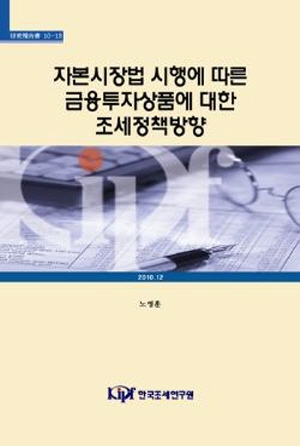자본시장법 시행에 따른 금융투자상품에 대한 조세정책방향
- Keyword
- 자본시장법, 자본시장법, 집합투자기구, 파생결합증권, 집합투자기구, 파생결합증권
- Title
- 자본시장법 시행에 따른 금융투자상품에 대한 조세정책방향
Tax Policy Direction on Financial Investment Product after the enactment of Korean Capital Market Act of 2009
- Authors
- 노영훈; RO; Younghoon; RO; Younghoon
- Issue Date
- 2010-12-01
2010-12-01
- Publisher
- KIPF
KIPF
- Page
- pp. 153
pp. 153
- Abstract
- 본 연구는 자본시장을 규율하는 법체계를 정비한 자본시장법의 시행으로 자본시장 내 금융투자상품의 복잡?다양화, 경쟁 심화에 따른 금융소비자 보호의 미흡, 그리고 조세회피형 신종금융상품의 개발 가능성이 높아진 현상에 주목하였다. 자본시장법은 금융투자상품을 크게 증권과 파생상품으로만 분류함에 따라 펀드 등 간접투자기구나 ELS와 같은 파생결합증권이 포괄적으로 규제되는 시대를 맞게 되었다. 이는 법 시행 이후 매우 복잡한 수익률 구조를 갖는 금융상품들이 형식적인 투자자 보호 권유준칙만 따르면 일반 개인투자자들에게 판매될 수 있음을 의미한다. 예를 들어, 손실위험 수용도가 높으면서 시장초과수익률을 추구하는 일반투자자는 금융회사가 공격투자형 성향으로 분류하여 이들에게 투자권유를 할 수 있는 금융상품범위에 'ELW, 선물옵션, 고수익 주식형펀드, 파생상품 등 위험자산‘이라는 매우 포괄적인 금융상품들을 판매할 수 있는 것이 현실이다. 특히 2003년 이후 급성장한 주가연계증권(ELS)의 경우, 발행사와 투자자 간에 기초자산인 개별종목 주식 또는 지수의 향후 움직임에 대한 시장정보 및 분석능력 측면에서 절대적 열위에 있는 개인투자자들에게 비정형화된 주식결합증권을 판매(권유)하면서 서명 등 형식적인 투자설명의무 확인만으로 투자자를 보호하기에는 미흡하다는 판단이다.
자본시장법 시행 이후 조세당국은 조세회피적 금융상품에 대응하면서 동시에 과세대우의 형평성을 유지하여야 하는 조세정책적 부담을 지게 되었는데, 특별규정들을 지속적으로 신설?보완하여 신속하게 문제를 해결하는 접근방식과 병행하여, 금융소비자 보호 차원에서 투자설명서 내에 관련 세후수익률을 명기할 수 있는 상품에 한하여 시판을 허용하는 세제당국 규제적 방안을 고려할 수 있을 것이다.
한편 2000년대 이후 펀드와 같은 간접투자시장이 급격히 팽창하면서 이에 대한 과세문제에 급박하게 대응하는 과정에서, 배당소득으로 ‘간주하는’ 과세원칙을 채택한 것은 상품 간 세제 형평성을 중시하여 시장 중립성을 확보한 적절한 조치라는 판단이다. 그러나 중장기적으로 펀드의 주된 구성자산 및 운용이 주식형일 경우 국내?외 주식을 불문하고 소득의 성격 측면에서 상장 및 협회등록 주식에 대한 양도차익 비과세제도와의 조화 문제는 지속적으로 해결해야 할 과제이다. 펀드투자의 본질은 개인투자자의 자금을 집합하여 전문투자지식을 갖춘 펀드매니저가 간접투자한다는 데에 있고, 직접투자에 비해 간접투자가 사회적으로 우대해야 할 금융투자 행태이기 때문에 정책목적상 우대해야 할 대상이라면 주식 직접투자수익에 비해 불리하게 과세되는 구체적인 사례들에 대한 분석위에 금융상품 전반에 대한 기본조세구조 개혁이 필요하다는 판단이다.
ELS와 같은 구조화가 복잡한 투자상품에 대한 소비자 보호를 위해서는 스위스나 독일 처럼 소비자의 상품에 대한 이해를 높이면서 환금성을 보장하는 거래소 상장화와 같은 제도적 개선을 고려해 볼 만하다. 기초자산 주식에 대한 직접투자와 비교하여 ELS는 매도를 통한 투자회수가 상당히 제약되어 위험성이 높다고 볼 수 있음에도 상장주식 매매차익에 대한 비과세와 달리 배당소득으로 과세하는 것은 세제적 불이익이라고 해석될 수도 있다. 오히려 일반투자자를 대상으로 한 ELS 판매는 시장평가 및 유동성 확보가 보장된 거래소 상장 ELS에 국한하고, 고객주문형 구조를 갖는 사모 ELS에 대해서만 상법상의 계약의 사적자치 원리에 따라 현행 투자권유 준칙에 따라 판매되도록 하는 것이 타당하다는 판단이다. 물론 양자 모두 수익의 성격, 원천 및 시간적 측면이 주식직접투자와 유사하므로 상장주식의 양도차익과세제도와 조화를 이루어야 할 것이다. 주가연계증권과 같은 구조화금융상품에 대한 세제문제는 상품을 분해한 개별 구성부분들에 대한 기존 개인소득세의 차등과세제도를 활용하여 조세회피적 상품구조설계를 하는 과정에서도 발생할 수 있는데 우리나라의 경우 ELS의 상장화를 통해 상당부분 해결할 수 있을 것이다.
With the enactment of Financial Investment Services and Capital Market Act(FSCMA, hereafter referred to as "CMA") in February 2009, investment funds and structured equity products expanded their market capitalization dramatically in Korea. Contrary to the previous separate special laws on securities, forwards, derivatives, trusts, they are now consolidated under the FSCMA regulations. It is no wonder that the regulation of the broad range of financial products under one FSCMA law entailed the intense competition among financial companies and the possible neglect of investor protection.
This study examines both the financial consumer protection and tax policy issues on investment funds and structured products which became very popular in the Korean capital market after 2000s.
In general, the investment fund tax rules are dictated largely by a country's overall tax regime for individuals and enterprises, and these tax regimes vary substantially among countries. In the context of these basic tax structure, the choice of tax rules for investment funds require balancing three objectives: first, not go impede the development of financial intermediaries; second, to devise tax rules that are compatible those that apply to other investments; and, third to adopt tax rules that can be administered and enforced. Among the four major different approaches of taxing investment funds, Korea adopted some mixture of tax-advantaged, pass-through, and surrogate prototypes. Investment fund is in essence characterized by two elements: collectiveness and intermediariness. Currently in Korea the income from an investment fund realized by an individual investor is categorized as dividend and taxed according to the genuine dividend income. But the tax treatment of dividend, interest, and capital gains at the investment fund level and at the level of the investors needs major reformatory change when the capital gains taxation on stock and shares under the progressive global income taxation is considered in future.
Since 2003 the Korean market of structured product became the huge business for banks and security companies. For example, the most popular two-asset reverse convertible type equity-linked securities(ELS) with knock-in barriers in Korea could offer a utility gain only for retail individual investors with the symmetrical information and analyzing know-how as the issuers. But in reality the retail investors bear knowledge asymmetry risk against the issuer, and tend to overpay. Also, there exists a possibility that the issuer's unwinding of a delta hedge position puts downward pressure on the underlying stock price to the investors disadvantage at redemption dates.
As the protection measure of retail investors, we suggest that customers understanding of the product should be enhanced through the compulsory listing of some ELS on the stock trade exchange rather than banning structured products completely (as is currently discussed in some countries). Other boutique type ELS sold privately to institutional investors does not need that level of customer protection if the two parties of investment contract fully share the full information of the product prospectus. Also, it would be an idea to introduce independent ranking that enables specific type of investors to see whether structured products add value to their portfolio or not.
- Keywords
- 자본시장법, 자본시장법, 집합투자기구, 파생결합증권, 집합투자기구, 파생결합증권
